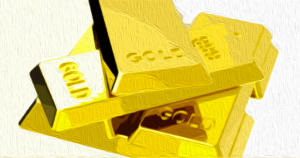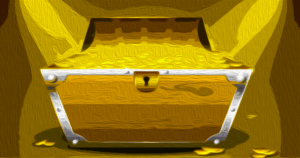Gold prices slipped yesterday as the Federal Open Market Committee (FOMC) concluded their September meeting, maintaining rates at a 22-year high. The committee's decision signaled that another rate hike would occur before the end of the year. Additionally, the FOMC revised its projection for 2024 rates, increasing them from 4.6% to 5.1%. As a result, the US dollar strengthened, while gold experienced a decline.
Gold's Performance before and after the FOMC Statement
Before the FOMC statement, gold made modest gains, approaching $1,950 per ounce, its highest point in two weeks. However, following the statement, it continued to decline for a third consecutive day, trading at around $1,925. This reaction was expected due to the FOMC's hawkish stance, expressing its commitment to at least one more rate hike this year and the anticipation of continued high rates into the following year.
The Significance of the FOMC Dot Plot
While the FOMC's statement resembled the one from July, there were notable differences in the September dot plot. The dot plot is a set of projections made by committee members based on their views of the economy and monetary policy. It provides insights into future rate decisions and helps identify trends and biases.
According to Bloomberg, the June and September dot plots indicate a shift towards a more hawkish stance. The projection for 2024 rates displayed a range of 4.875% to 5.375%, compared to June's dot plot with a mode of 4.375%. This shift represents a significant change of up to 100 basis points.
The Fed's Outlook on Inflation
The Federal Reserve appears optimistic about the economy, reflecting in their statement, which displays a dovish tone. They project a 2.1% growth rate for this year, a notable improvement from the 1% projection in June. Furthermore, the Fed maintains its confidence that high rates are not causing a recession, contrary to concerns raised by some experts.
However, the Organization for Economic Cooperation and Development (OECD) disagrees with the Fed's assessment. In its interim economic outlook, the OECD downgraded its economic forecasts for the next year, highlighting the visible impact of tighter monetary policies on business and consumer confidence, as well as the fading rebound in China.
Although the Fed believes high rates are not causing significant harm, they acknowledge the ongoing battle with inflation. Inflation remains above the targeted 2%, and the Fed's projections anticipate a return to this level only by 2026. Despite this, the Fed maintains a dovish stance on economic performance.
Confusion and Uncertainty Surrounding the FOMC's Actions
The FOMC's actions and statements during this meeting have left many observers confused and uncertain. As economist Mohammed El Erian expressed, the mixed signals and unclear communication from the Federal Reserve may create confusion among the public.
The market's reactions, such as the decline in equities and the increase in Treasuries and oil, illustrate the volatility caused by projections that are bound to change over time. Traders should anticipate data revisions and new statements, indicating the inherent uncertainty and possibility for errors in these projections.
A Global Issue
Monetary policy meetings are not limited to the US. The Bank of England, located in the UK, will convene later today. Initially, the market expected the Bank of England's Monetary Policy Committee to hike rates for the 15th consecutive time. However, improved inflation data contradicted these expectations, resulting in a 6.7% inflation rate instead of the forecasted 7%. Consequently, market predictions regarding rate hikes became divided.
Previously seen as the weak point in Europe due to Brexit and leadership issues, the UK now faces uncertainty surrounding its monetary policy. Similarly, the European Central Bank (ECB) recently raised rates to their highest level since the inception of the Euro. Surprisingly, this move did not boost the Euro's performance, which instead experienced a drop against the US dollar. This disparity undermines confidence in the ECB's ability to exert control over the situation.
A Lack of Control
The global economy faces numerous sustainability challenges, and very little appears to be under control. The Institute of International Finance's global debt monitor report highlights the rising share of borrowing as a percentage of GDP, which reached 336% in June. Higher interest rates are intensifying borrowing costs and placing significant strain on governments.
Given these circumstances, gold's reaction to the FOMC meeting is not a cause for concern. The statements and projections made by the Federal Reserve and other institutions are essentially uncertain calculations. Therefore, it is crucial to recognize the limited reliability of these predictions in the larger economic context.
Final Thoughts
Some individuals speculate if Liz Truss's departure as the UK's shortest-lived prime minister happened too quickly. During her speech, Truss emphasized the role of central banks in injecting large sums of money into the system and keeping interest rates artificially low, which indirectly enables excessive government spending. This observation prompts reflection on the actions and abilities of central banks.
The post Gold Slips as Fed Signals More Hikes to Come appeared first on GoldCore News.
Frequently Asked Questions
Which type is best for an IRA?
The most important thing when choosing an IRA for you is to find one that fits within your goals and lifestyle. You must consider whether you want to maximize tax-deferred growth on your contributions, minimize taxes now and pay penalties later, or just avoid taxes altogether.
If you're saving for retirement and don't have much money invested, the Roth option could make sense. The Roth option is also a smart choice if you work beyond the age of 59 1/2 and plan to pay income tax on any withdrawals.
The traditional IRA is better if you want to retire earlier because you will likely owe tax on your earnings. But if you're going to work well past age 65, the Roth IRA might make more sense since it allows you to withdraw some or all of your earnings without paying taxes.
Which is stronger? 14k Gold or Sterling Silver?
Gold and silver are strong metals, but sterling silver is much less expensive because it contains 92% pure silver rather than just 24%.
Sterling silver, also known as fine or sterling silver, is made of a combination of silver and other metals like copper and zinc.
It is generally believed that gold is very strong. It is very difficult to separate it from its metal counterpart. If you drop something on top of a chunk of gold it will shatter into thousands of pieces rather than breaking into two halves.
However, silver doesn't have the same strength as gold. If you dropped an item onto silver sheets, it would likely fold and bend without cracking.
Silver is used in jewelry and coins. Because of this, silver's value is subject to fluctuations based upon supply and demand.
Can I add gold to my IRA?
Yes! Gold can be added to your retirement plan. Because it doesn’t lose value over the years, gold makes a good investment. It is also immune to inflation. It is also exempt from taxes.
Before you invest in gold, make sure to understand its differences from other investments. You can't purchase shares in gold companies, unlike stocks and bonds. These shares can also be not sold.
Instead, you must convert your gold to cash. This means that you'll have to get rid of it. It's not enough to hold on to it.
This makes gold different from other investments. Like other investments, you can always dispose of them later. With gold, this isn't true.
Worse, the gold cannot be used as collateral for loans. If you get a mortgage, for example, you might have to give up some of the gold you own in order to pay off the loan.
What does that mean? Your gold can't be kept forever. You'll eventually need to convert it into cash.
You don't need to worry. Open an IRA account. You can then invest in gold.
What precious metals are permitted in an IRA
The most commonly used precious metal in IRA accounts is, of course, gold. You can also invest in gold bullion bars and coins.
Precious and precious metals are considered safe investments, as they don’t lose their value over the course of time. They can also be used to diversify investment portfolios.
Precious metals include palladium and platinum. These three metals have similar properties. Each has its own purpose.
For example, platinum is used in making jewelry. The catalysts are made from palladium. The production of coins is done with silver.
Think about how much you can afford to purchase your gold, before you make a decision on the precious metal. You might be better off buying gold that costs less per ounce.
Also, think about whether or not you wish to keep your investment secret. If you are unsure, palladium is the right choice.
Palladium is more expensive than gold. It's also more rare than gold. So you'll likely have to pay more for it.
Another important factor when choosing between gold and silver is their storage fees. You store gold by weight. So you'll pay a higher fee for storing larger amounts of gold.
Silver can be stored by volume. Therefore, smaller amounts of silver will cost less.
You should follow all IRS rules if you plan to store precious metals in an IRA. This includes keeping track and reporting transactions to the IRS.
What is the best precious metal to invest in?
Investments in gold offer high returns on their capital. It is also immune to inflation and other risk factors. As people worry about inflation, the price of gold tends increase.
It is a smart idea to buy gold futures. These contracts guarantee that you will receive certain amounts of gold at a given price.
But gold futures may not be right for everyone. Some prefer to have physical gold.
They can easily trade their gold with others. They can also easily sell it whenever they like.
Some people also prefer to avoid paying taxes on their gold. They buy gold directly from government to do this.
This will require several trips to your local Post Office. You must first convert any existing gold into coins or bars.
Then you will need a stamp to attach the coins or bars. Finally, send the coins or bars to the US Mint. There, they melt down the coins and bars into new ones.
These new coins, bars, and bars have the original stamps stamped onto them. This means they are legal tender.
But if you buy gold directly from the US Mint, you won't have to pay taxes.
What precious metal would your investment preference be?
What is a Precious Metal IRA?
Precious metals make a great investment in retirement accounts. They have held their value since biblical times. A great way to diversify and protect your portfolio is to invest in precious metals such silver, gold, and platinum.
Some countries also allow citizens to keep their money in foreign currency. You can buy Canadian gold bars and keep them at home. Then, when you travel to Canada, you can make the same gold bars and sell them for Canadian Dollars.
This is a very easy way to invest in precious metals. It's especially useful if you live outside of North America.
Statistics
- Depending on your financial situation, most experts recommend you invest no more than 5% to 10% of your retirement funds in precious metals. (forbes.com)
- The maximum yearly contribution to an individual's IRAs is currently $6,000 ($7,000 for those 50 years or older), or 100% of earned income, whichever is less. (monex.com)
- You can only purchase gold bars of at least 99.5% purity. (forbes.com)
- Same tax rules as traditional IRA SEP IRA contributions in 2022 are limited to 25% of compensation or $66,000, whichever is less Before setting up a Silver IRA, understand the fees and IRS restrictions. (sltrib.com)
External Links
investopedia.com
en.wikipedia.org
wsj.com
kitco.com
How To
How to Decide if a Gold IRA ‘Is Right For You'
Individual Retirement accounts (IRAs) are the most common type of retirement account. IRAs can also be purchased through banks, mutual funds, financial planners, and other institutions. The IRS allows individuals to contribute up to $5,000 annually without tax consequences. This amount can be contributed to any IRA, regardless of your age. However, there are limits on how much money you can put into certain IRAs. For example, a Roth IRA contribution is not allowed if you are less than 59 1/2. Contributions must be made by those under 50 years old. Individuals who work for their employer could be eligible for matching employer contributions.
There are two types of IRAs available: Roth and traditional. Traditional IRAs can be used to invest in stocks or bonds, as well other investments. Roth IRAs are only available for after-tax dollars. Roth IRA contributions are not subject to tax when they are made, but Roth IRA withdrawals are. Some people prefer to combine these two accounts. There are pros and cons to each type of IRA. How do you choose the best type of IRA for you? Three things to bear in mind before you decide which type of IRA is best for you:
Traditional IRA pros:
- Each company has its own contribution options
- Employer match possible
- More than $5,000 in savings per person
- Gain tax-deferred until withdrawal
- Limitations may apply based on income levels
- Maximum annual contribution is $5,500 ($6,500 for married couples filing jointly).
- The minimum investment is $1,000
- You must start receiving mandatory distributions after age 70 1/2
- For an IRA to be opened, you must have at least five-years-old
- Cannot transfer assets from IRAs
Roth IRA Pros:
- No taxes owed when contributing
- Earnings increase without tax
- No minimum distributions
- Only stocks, bonds, mutual funds are available as investment options.
- There is no maximum contribution limit
- There are no restrictions on the transfer of assets between IRAs
- To open an IRA, you must be 55 years old or older
If you are thinking about opening an IRA, it is important to be aware that not all companies offer exactly the same IRAs. Some companies allow you to choose between a Roth IRA or a traditional IRA. Others allow you to combine them. It's also worth noting that different types of IRAs have different requirements. Roth IRAs don't have a minimum capital requirement. Traditional IRAs only require a $1,000 minimum investment.
The bottom line
When you are choosing an IRA, it is crucial to consider whether you will pay taxes now or in the future. A traditional IRA may be the right choice if you retire within ten years. A Roth IRA may be a better choice for you. Whatever your situation, it's a good idea that you consult a professional about retirement planning. An expert can advise you on the best options and how to navigate the market.
—————————————————————————————————————————————————————————————-
By: Dave Russell
Title: Gold Prices Decline as Federal Reserve Indicates More Rate Hikes
Sourced From: news.goldcore.com/fomc-dot-plot-gold/
Published Date: Thu, 21 Sep 2023 10:25:12 +0000














